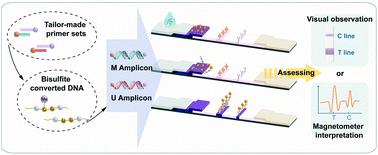Our official English website, www.x-mol.net, welcomes your
feedback! (Note: you will need to create a separate account there.)
A site-specific DNA methylation biosensor for both visual and magnetic determination based on lateral flow assay
Analyst ( IF 3.6 ) Pub Date : 2021-2-18 , DOI: 10.1039/d0an02277b Jiaxing Zhang 1, 2, 3, 4 , Xiaonan Liu 1, 2, 3, 4 , Sinong Zhang 1, 2, 3, 4 , Yu Cai 1, 2, 3, 4 , Kang Ma 1, 2, 3, 4 , Kai Hua 1, 2, 3, 4 , Yali Cui 1, 2, 3, 4
Analyst ( IF 3.6 ) Pub Date : 2021-2-18 , DOI: 10.1039/d0an02277b Jiaxing Zhang 1, 2, 3, 4 , Xiaonan Liu 1, 2, 3, 4 , Sinong Zhang 1, 2, 3, 4 , Yu Cai 1, 2, 3, 4 , Kang Ma 1, 2, 3, 4 , Kai Hua 1, 2, 3, 4 , Yali Cui 1, 2, 3, 4
Affiliation

|
Tumorigenesis driven by abnormal DNA methylation has highlighted the need to develop a portable, rapid and sensitive strategy for accurate methylation detection with a specific cancer-prognostic gene, which caters to the popularization of precision medicine. In this study, a site-specific biosensor for both visual and magnetic DNA methylation determination has been established based on lateral flow assay. By introducing digoxin- and biotin-labeled primers into PCR, the amplicons can be recognized and captured by gold magnetic nanoparticles (GMNPs) in this biosensor. Working as a signal probe, the optical property of GMNPs allows the amplicons to be interpreted with naked eyes avoiding any complex equipment and cumbersome operation after PCR. Moreover, by virtue of the magnetic property of GMNP, the signal can be explained and recorded by a magnetometer in clinical practice. The introduction of tailor-made primer sets makes it possible to accurately distinguish 0.1% methylated variants in the presence of numerous unmethylated variants as strong interferential background and vice versa at target cytosine–guanine dinucleotide. A distinct signal can be observed with as low as 0.01 pg variants for both visual and magnetic analyses. As a significant tumor suppressor gene, the promoter methylation status of miR-34a is accurately determined with not only cell lines but also with clinical samples, which demonstrates the great potential of this biosensor for cancer diagnosis and prognosis.
中文翻译:

基于侧向流动检测的视觉和磁性测定的特定位点DNA甲基化生物传感器
由异常DNA甲基化驱动的肿瘤发生突显了需要开发一种可移植,快速且灵敏的策略,以使用特定的癌症预后基因进行准确的甲基化检测,以迎合精密医学的普及。在这项研究中,基于侧向流动测定法,已经建立了用于视觉和磁性DNA甲基化测定的位点特异性生物传感器。通过将地高辛和生物素标记的引物引入PCR,该生物传感器中的金磁性纳米颗粒(GMNP)可以识别并捕获扩增子。GMNPs用作信号探针,其光学特性允许用肉眼解释扩增子,从而避免了PCR后的任何复杂设备和繁琐的操作。此外,凭借GMNP的磁性,该信号可以在临床实践中通过磁力计进行解释和记录。量身定制的引物组的引入使得在存在大量未甲基化变体作为强干扰本底和背景的情况下,准确区分0.1%甲基化变体成为可能。反之亦然,目标胞嘧啶-鸟嘌呤二核苷酸。视觉和磁性分析均可观察到低至0.01 pg的变异信号。作为重要的抑癌基因,miR-34a的启动子甲基化状态不仅可以通过细胞系而且可以通过临床样品准确确定,这证明了这种生物传感器在癌症诊断和预后方面的巨大潜力。
更新日期:2021-02-18
中文翻译:

基于侧向流动检测的视觉和磁性测定的特定位点DNA甲基化生物传感器
由异常DNA甲基化驱动的肿瘤发生突显了需要开发一种可移植,快速且灵敏的策略,以使用特定的癌症预后基因进行准确的甲基化检测,以迎合精密医学的普及。在这项研究中,基于侧向流动测定法,已经建立了用于视觉和磁性DNA甲基化测定的位点特异性生物传感器。通过将地高辛和生物素标记的引物引入PCR,该生物传感器中的金磁性纳米颗粒(GMNP)可以识别并捕获扩增子。GMNPs用作信号探针,其光学特性允许用肉眼解释扩增子,从而避免了PCR后的任何复杂设备和繁琐的操作。此外,凭借GMNP的磁性,该信号可以在临床实践中通过磁力计进行解释和记录。量身定制的引物组的引入使得在存在大量未甲基化变体作为强干扰本底和背景的情况下,准确区分0.1%甲基化变体成为可能。反之亦然,目标胞嘧啶-鸟嘌呤二核苷酸。视觉和磁性分析均可观察到低至0.01 pg的变异信号。作为重要的抑癌基因,miR-34a的启动子甲基化状态不仅可以通过细胞系而且可以通过临床样品准确确定,这证明了这种生物传感器在癌症诊断和预后方面的巨大潜力。











































 京公网安备 11010802027423号
京公网安备 11010802027423号